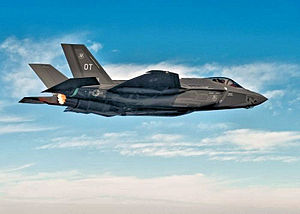422d Test and Evaluation Squadron
 | |
|---|---|
 Squadron F-35A Lightning II[note 1] | |
| Active | 1943–1945; 1969–present |
| Country | |
| Branch | |
| Type | Squadron |
| Role | Operational testing |
| Part of | Air Combat Command |
| Garrison/HQ | Nellis Air Force Base, Nevada |
| Engagements |
|
| Decorations |
|
| Insignia | |
| 422d Test and Evaluation Squadron emblem[note 2][1] |  |
The 422d Test and Evaluation Squadron is a United States Air Force unit. It is assigned to the 53d Test and Evaluation Group, stationed at Nellis Air Force Base, Nevada. The squadron performs operational testing of all fighter aircraft and munitions entering and in operational use by Air Combat Command.
The unit was originally formed as the 422d Night Fighter Squadron in 1943. After training in the United States, it was deployed to Ninth Air Force in England in the spring of 1944, prior to the D-Day landings in France. During the run-up to D-Day, the squadron trained with Royal Air Force night fighter units against Luftwaffe raiders who intruded the night skies over England. It was the first American squadron in England equipped with the Northrop P-61 Black Widow night fighter. After the landings in France, the mission of the squadron became the air defense of Allied liberated territory. During the Battle of the Bulge, it also flew day and night interdiction missions against enemy troop movements, bridges and other targets of opportunity. It was inactivated shortly after the war in Europe ended.
In 1969, the squadron was reactivated at Nellis Air Force Base by Tactical Air Command to provide combat evaluation and operational testing of new USAF aircraft entering the inventory after developmental testing was completed at Edwards Air Force Base.
Cite error: There are <ref group=note> tags on this page, but the references will not show without a {{reflist|group=note}} template (see the help page).
- ^ a b c "422 Test and Evaluation Squadron". Air Force Historical Research Agency. 7 April 2008. Retrieved 4 July 2017.